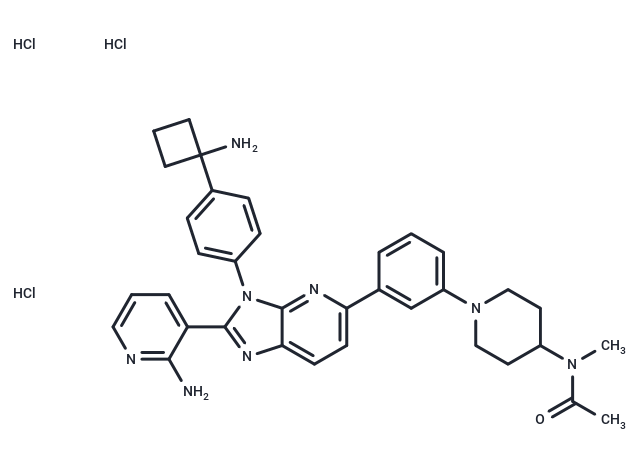Shopping Cart
Remove All Your shopping cart is currently empty
Your shopping cart is currently empty
Vevorisertib trihydrochloride (ARQ 751 trihydrochloride) is a selective and potent inhibitor of pan-AKT and AKT1-E17K mutations, inhibiting AKT1, AKT2 and AKT3. Vevorisertib trihydrochloride is used in the study of hepatocellular carcinoma and advanced solid tumours.

| Pack Size | Price | USA Warehouse | Global Warehouse | Quantity |
|---|---|---|---|---|
| 1 mg | $60 | In Stock | In Stock | |
| 5 mg | $145 | In Stock | In Stock | |
| 10 mg | $233 | In Stock | In Stock | |
| 25 mg | $397 | In Stock | In Stock | |
| 50 mg | $582 | In Stock | In Stock | |
| 100 mg | $779 | In Stock | In Stock | |
| 1 mL x 10 mM (in DMSO) | $223 | In Stock | In Stock |
| Description | Vevorisertib trihydrochloride (ARQ 751 trihydrochloride) is a selective and potent inhibitor of pan-AKT and AKT1-E17K mutations, inhibiting AKT1, AKT2 and AKT3. Vevorisertib trihydrochloride is used in the study of hepatocellular carcinoma and advanced solid tumours. |
| Targets&IC50 | Akt1:1.2 nM (Kd), Akt1:0.55 nM, Akt2:0.81 nM, Akt3:1.31 nM, Akt1 (E17K):8.6 nM (Kd) |
| In vitro | Vevorisertib trihydrochloride at concentrations ranging from 0 to 1000 nM over 2 hours inhibits the phosphorylation of AKT1-E17K. In NIH 3T3 cells transfected with pcDNAAKT-WT-GFP or pcDNA-E17K-GFP and treated with 1 μM of the compound for the same duration, it prevents the plasma membrane translocation of both AKT-WT and AKT1-E17K, regardless of growth factor presence. Additionally, a 5 μM concentration results in 57% inhibition of full-length AKT1. The compound demonstrates a dose-dependent impact on mTORC1 and AKT substrates, such as PRAS40, GSK3β, FOXO, BAD, and AS160 across various cancer cell lines with distinct concentrations (0 to 1 μM, 2 hours). It also exhibits significant anti-proliferative effects on esophageal, breast, and head and neck cancer cells, with GI 50 values below 1 μM, and showcases potent efficacy in PIK3CA mutant cell lines. Moreover, a combination of Vevorisertib trihydrochloride (MK-4440) and imatinib mesylate leads to cell cycle arrest and increased cell death in gastrointestinal stromal tumor cells. Western Blot analyses reveal the compound's effectiveness in inhibiting phosphorylation of AKT1-E17K and dose-dependent effects on mTORC1 and AKT substrates across different cell lines, including those with PIK3CA mutations and various cancer-related mutations. |
| In vivo | Vevorisertib trihydrochloride administered orally at doses of 25, 50, and 75 mg/kg for five consecutive days followed by a four-day break over a 20-day period demonstrated significant tumor growth inhibition rates of 68%, 78%, and 98%, respectively, in endometrial PDX mouse xenograft models featuring the AKT1-E17K mutation. When administered daily at varying doses (5, 10, 20, 40, 80, and 120 mg/kg) for ten days in AN3CA mouse xenograft models, it showed tumor growth inhibition rates ranging from 29% to 92%. The compound achieved C max plasma concentrations of ≥2 μM and was generally well-tolerated at all administered doses up to 120 mg/kg. Additionally, a combination of Vevorisertib trihydrochloride (MK-4440) and IM exhibited superior efficacy in an IM-sensitive preclinical GIST model compared to either agent alone, highlighting its potential as a robust therapeutic candidate in specific cancer models. |
| Synonyms | ARQ 751 trihydrochloride |
| Molecular Weight | 696.12 |
| Formula | C35H41Cl3N8O |
| Cas No. | 1416775-08-0 |
| Smiles | Cl.Cl.Cl.CN(C1CCN(CC1)c1cccc(c1)-c1ccc2nc(-c3cccnc3N)n(-c3ccc(cc3)C3(N)CCC3)c2n1)C(C)=O |
| Storage | store at low temperature,keep away from direct sunlight | Powder: -20°C for 3 years | In solvent: -80°C for 1 year | Shipping with blue ice/Shipping at ambient temperature. | ||||||||||||||||||||||||||||||||||||||||
| Solubility Information | H2O: 20 mg/mL (28.73 mM), Sonication is recommended. DMSO: 100 mg/mL (143.65 mM), Sonication is recommended. | ||||||||||||||||||||||||||||||||||||||||
| In Vivo Formulation | 10% DMSO+40% PEG300+5% Tween 80+45% Saline: 5 mg/mL (7.18 mM), Sonication is recommended. Please add the solvents sequentially, clarifying the solution as much as possible before adding the next one. Dissolve by heating and/or sonication if necessary. Working solution is recommended to be prepared and used immediately. The formulation provided above is for reference purposes only. In vivo formulations may vary and should be modified based on specific experimental conditions. | ||||||||||||||||||||||||||||||||||||||||
Solution Preparation Table | |||||||||||||||||||||||||||||||||||||||||
H2O/DMSO
DMSO
| |||||||||||||||||||||||||||||||||||||||||
| Size | Quantity | Unit Price | Amount | Operation |
|---|

Copyright © 2015-2026 TargetMol Chemicals Inc. All Rights Reserved.